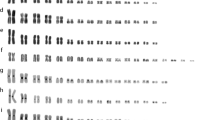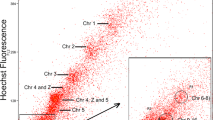Abstract
The divergence of lineages leading to extant squamate reptiles (lizards, snakes, and amphisbaenians) and birds occurred about 275 million years ago. Birds, unlike squamates, have karyotypes that are typified by the presence of a number of very small chromosomes. Hence, a number of chromosome rearrangements might be expected between bird and squamate genomes. We used chromosome-specific DNA from flow-sorted chicken (Gallus gallus) Z sex chromosomes as a probe in cross-species hybridization to metaphase spreads of 28 species from 17 families representing most main squamate lineages and single species of crocodiles and turtles. In all but one case, the Z chromosome was conserved intact despite very ancient divergence of sauropsid lineages. Furthermore, the probe painted an autosomal region in seven species from our sample with characterized sex chromosomes, and this provides evidence against an ancestral avian-like system of sex determination in Squamata. The avian Z chromosome synteny is, therefore, conserved albeit it is not a sex chromosome in these squamate species.








Similar content being viewed by others
References
Andrews R (2005) Incubation temperature and sex ratio of the veiled chameleon (Chamaeleo calyptratus). J Herpetol 39:515–518
Bellott DW, Skaletsky H, Pyntikova T, Mardis ER, Graves T, Kremitzki C, Brown LG, Rozen S, Warren WC, Wilson RK, Page DC (2010) Convergent evolution of chicken Z and human X chromosomes by expansion and gene acquisition. Nature 466:612–616
Brunner B, Hornung U, Shan Z, Nanda I, Kondo M, Zend-Ajusch E, Haaf T, Ropers HH, Shima A, Schmid M, Kalscheuer VM, Schartl M (2001) Genomic organization and expression of the doublesex-related gene cluster in vertebrates and detection of putative regulatory regions for DMRT1. Genomics 77:8–17
Caputo V, Odierna G, Aprea G (1994) A chromosomal study of Eumeces and Scincus, primitive members of the Scincidae (Reptilia, Squamata). Boll Zool 61:155–162
Chowdhary BP, Raudsepp T (2000) HSA4 and GGA4: remarkable conservation despite 300-Myr divergence. Genomics 64:102–105
Ellegren H (2010) Evolutionary stasis: the stable chromosomes of birds. Trends Ecol Evol 25:283–291
Ezaz T, Quinn AE, Miura I, Sarre D, Georges A, Graves JAM (2005) The dragon lizard Pogona vitticeps has ZZ/ZW micro-sex chromosomes. Chromosome Res 13:763–776
Ezaz T, Quinn AE, Sarre SD, O’Meally D, Georges A, Graves JAM (2009a) Molecular marker suggests rapid changes of sex-determining mechanisms in Australian dragon lizards. Chromosome Res 17:91–98
Ezaz T, Moritz B, Waters PD, Graves JAM, Georges A, Sarre SD (2009b) The ZW sex microchromosomes of an Australian dragon lizard share no homology with those of other reptiles or birds. Chromosome Res 17:965–973
Ezaz T, Sarre SD, O’Meally D, Graves JAM, Georges A (2010) Sex chromosome evolution in lizards: independent origins and rapid transitions. Cytogenet Genome Res 127:249–260
Ferguson-Smith MA, Trifonov V (2007) Mammalian karyotype evolution. Nat Rev Genet 8:950–962
Fridolfsson AK, Cheng H, Copeland NG, Jenkins NA, Liu HC, Raudsepp T, Woodage T, Chowdhary B, Halverson J, Ellegren H (1998) Evolution of the avian sex chromosomes from an ancestral pair of autosomes. Proc Natl Acad Sci USA 95:8147–8152
Gamble T, Bauer AM, Greenbaum E, Jackman TR (2008) Out of the blue: a novel, trans-Atlantic clade of gecko lizards (Gekkota, Squamata). Zool Scri 37:355–366
Giovannotti M, Caputo V, O’Brien PCM, Lovell FL, Trifonov V, Nisi Cerioni P, Olmo E, Ferguson-Smith MA, Rens W (2009) Skinks (Reptilia: Scincidae) have highly conserved karyotypes as revealed by chromosome painting. Cytogenet Genome Res 127:224–231
Glas R, Graves JAM, Toder R, Ferguson-Smith MA, O’Brien PCM (1999) Cross-species chromosome painting between human and marsupial directly demonstrates the ancient region of the mammalian X. Mamm Genome 10:1115–1116
Gorman GC, Gress F (1970) Sex chromosomes of a pygopodid lizard, Lialis burtonis. Experientia 26:206–207
Graves JAM (2009) Weird animal genomes and the evolution of vertebrate sex and sex chromosomes. Annu Rev Genet 42:565–586
Graves JAM, Shetty S (2001) Sex from W to Z: evolution of vertebrate sex chromosomes and sex determining genes. J Exp Zool 290:449–462
Itoh Y, Kampf K, Arnold AP (2006) Comparison of the chicken and zebra finch Z chromosomes shows evolutionary rearrangements. Chromosome Res 14:805–815
Ivanov VG, Bogdanov OP, Anislmova EY, Fedorova TA (1973) Studies of the karyotypes of three lizard species (Sauria, Scincidae, Lacertidae). Tsitologiya 15:1291–1296
Janes DE, Organ CL, Fujita MK, Shedlock AM, Edwards SV (2010) Genome evolution in Reptilia, the sister group of mammals. Annu Rev Genomics Hum Genet 11:239–264
Kasai F, O’Brien PTM, Martin S, Ferguson-Smith MA (2003) Identification of the homologue of chicken Z chromosome in turtle and crocodile. Ann Génét 46:89
Kawai A, Nishida-Umehara C, Ishijima J, Tsuda Y, Ota H, Matsuda Y (2007) Different origins of bird and reptile sex chromosomes inferred from comparative mapping of chicken Z-linked genes. Cytogenet Genome Res 117:92–102
Kawai A, Ishijima J, Nishida C, Kosaka A, Ota H, Kohno SI, Matsuda Y (2009) The ZW sex chromosomes of Gekko hokouensis (Gekkonidae, Squamata) represent highly conserved homology with those of avian species. Chromosoma 118:43–51
Kejnovský E, Leitch I, Leitch A (2009) Contrasting evolutionary dynamics between angiosperm and mammalian genomes. Trends Ecol Evol 24:572–582
King M, Mengden GA, King D (1982) A pericentric-inversion polymorphism and a ZZ/ZW sex-chromosome system in Varanus acanthurus Boulenger analyzed by G- and C-banding and Ag staining. Genetica 58:39–45
Larkin MA, Blackshields G, Brown NP, Chenna R, McGettigan PA, McWilliam H, Valentin F, Wallace IM, Wilm A, Lopez R, Thompson JD, Gibson TJ, Higgins DG (2007) ClustalW and ClustalX version 2.0. Bioinformatics 23:2947–2948
Li Y, Zhang LQ, Zhang DX, Zhang XQ, Lu XM (2010) Faster evolution of Z-linked duplicate genes in chicken. J Genet Genomics 37:695–702
Matsubara K, Tarui H, Toriba M, Yamada K, Nishida-Umehara Ch, Agata K, Matsuda Y (2006) Evidence for different origin of sex chromosomes in snakes, birds, and mammals and stepwise differentiation of snake sex chromosomes. Proc Natl Acad Sci USA 103:18190–18195
Matsuda Y, Nishida-Umehara Ch, Tarui H, Kuroiwa A, Yamada K, Isobe T, Ando J, Fujiwara A, Hirao Y, Nishimura O, Ishijima J, Hayashi A, Saito T, Murakami T, Murakami Y, Kuratani S, Agata K (2005) Highly conserved linkage homology between birds and turtles: bird and turtle chromosomes are precise counterparts of each other. Chromosome Res 13:601–615
Mühlmann-Díaz MC, Ulsh BA, Whicker FW, Hinton TG, Congdon JD, Robinson JF, Bedford JS (2001) Conservation of chromosome 1 in turtles over 66 million years. Cytogenet Cell Genet 92:139–143
Nakatani Y, Takeda H, Kohara Y, Morishita S (2007) Reconstruction of the vertebrate ancestral genome reveals dynamic genome reorganization in early vertebrates. Genome Res 17:1254–1265
Nanda I, Haaf T, Schartl M, Schmid M, Burt DW (2002) Comparative mapping of Z-orthologous genes in vertebrates: implications for the evolution of avian sex chromosomes. Cytogenet Genome Res 99:178–184
Nishida-Umehara C, Tsuda Y, Ishijima J, Ando J, Fujiwara A, Matsuda Y, Griffin DK (2007) The molecular basis of chromosome orthologies and sex chromosomal differentiation in palaeognathous birds. Chromosome Res 15:721–734
O’Meally D, Patel HR, Stiglec R, Sarre SD, Geordes A, Graves JAM, Ezaz T (2010) Non-homologous sex chromosomes of birds and snakes share repetitive sequences. Chromosome Res 18:787–800
Olmo E (1986) A reptilia. In: John B (ed) Animal cytogenetics 4, Chordata 3. Gebrueder Borntraeger, Berlin, pp 1–100
Olmo E (2008) Trends in the evolution of reptilian chromosomes. Integr Comp Biol 48:486–493
Organ C, Janes DE (2008) Evolution of sex chromosomes in Sauropsida. Integr Comp Biol 48:512–519
Pokorná M, Kratochvíl L (2009) Phylogeny of sex-dermining mechanisms in squamate reptiles: are sex chromosomes an evolutionary trap? Zool J Linn Soc 156:168–183
Pokorná M, Rábová M, Ráb P, Ferguson-Smith MA, Rens W, Kratochvíl L (2010) Differentiation of sex chromosomes and karyotypic evolution in the eye-lid geckos (Squamata: Gekkota: Eublepharidae), a group with different modes of sex determination. Chromosome Res 18:809–820
Ráb P, Rábová M, Pereira CS, Collares-Pereira MJ, Pelikánová Š (2008) Chromosome studies of European cyprinid fishes: interspecific homology of leuciscine cytotaxonomic marker—the largest subtelocentric chromosome pair as revelaed by cross-species painting. Chromosome Res 16:863–873
Rens W, O’Brien PCM, Yang F, Graves JAM, Ferguson-Smith MA (1999) Karyotype relationships between four distantly related marsupials revealed by reciprocal chromosome painting. Chromosome Res 7:461–474
Rens W, O’Brien PCM, Yang F, Solanky N, Perelman P, Graphodatsky AS, Ferguson MW, Svartman M, De Leo AA, Graves JAM, Ferguson-Smith MA (2001) Karyotype relationships between distantly related marsupials from South America and Australia. Chromosome Res 9:301–308
Rens W, O’Brien PCM, Fairclough H, Harman L, Graves JAM, Ferguson-Smith MA (2003) Reversal and convergence in marsupial chromosome evolution. Cytogenet Genome Res 102:282–290
Rens W, Fu B, O’Brien PCM, Ferguson-Smith MA (2006) Cross-species chromosome painting. Nat Protoc 1:783–790
Rens W, O’Brien PCM, Grützner F, Clarke O, Graphodatskaya D, Tsend-Ayush E, Trifonov VA, Skelton H, Wallis MC, Johnston S, Veyrunes F, Graves JAM, Ferguson-Smith MA (2007) The multiple sex chromosomes of platypus and echidna are not completely identical and several share homology with the avian Z. Genome Biol 8:R243
Seipp R, Henkel FW (2000) Rhacodactylus: biology, natural history and husbandry. Edition Chimaira, Germany
Shedlock AM, Edwards SV (2009) Amniota. In: Hedges SB, Kumar S (eds) The timetree of life. Oxford University Press, New York, pp 375–379
Shetty S, Griffin DK, Graves JAM (1999) Comparative painting reveals strong chromosome homology over 80 million years of bird evolution. Chromosome Res 7:289–295
Shibaike Y, Takahashi Y, Arikura I, Iiizumi R, Kitakawa S, Sakai M, Imaoka C, Shiro H, Tanaka H, Akakubo N, Nakano M, Watanabe M, Ohne K, Kubota S, Kohno S, Ota H (2009) Chromosome evolution in the lizard genus Gekko (Gekkonidae, Squamata, Reptilia) in the east Asian islands. Cytogenet Genome Res 127:182–190
Smith JJ, Voss SR (2007) Bird and mammal sex chromosome orthologs map to the same autosomal region in salamander (Ambystoma). Genetics 177:607–613
Solleder E, Schmid M (1984) XX/XY-sex chromosomes in Gekko gecko (Sauria, Reptilia). Amphibia-Reptilia 5:339–345
Srikulnath K, Nishida C, Matsubara K, Uno Y, Thongpan A, Suputtitada S, Apisitwanich S, Matsuda Y (2009) Karyotypic evolution in squamate reptiles: comparative gene mapping revealed highly conserved linkage homology between the butterfly lizard (Leiolepis reevesii rubritaeniata, Agamidae, Lacertilia) and the Japanese four-striped rat snake (Elaphe quadrivirgata, Colubridae, Serpentes). Chromosome Res 17:975–986
Telenius H, Pelmear AH, Tunnacliffe A, Carter NP, Behmel A, Ferguson-Smith MA, Nordenskjöld M, Pfragner R, Ponder BA (1992) Cytogenetic analysis by chromosome painting using DOP-PCR amplified flow-sorted chromosomes. Genes Chromosom Cancer 4:257–263
Veyrunes F, Waters Paul D, Miethke P, Rens W, McMillan D, Alsop AE, Frank G, Deakin JE, Whittington CM, Schatzkamer K, Kremitzki CL, Graves T, Ferguson-Smith MA, Warren W, Graves JAM (2008) Bird-like sex chromosomes of platypus imply recent origin of mammal sex chromosomes. Genome Res 18:965–973
Vidal N, Hedges SB (2005) The phylogeny of squamate reptiles (lizards, snakes, and amphisbaenians) inferred from nine nuclear protein-coding genes. C R Biol 328:1000–1008
Yang F, Carter NP, Shi L, Ferguson-Smith MA (1995) A comparative study of karyotypes of muntjacs by chromosome painting. Chromosoma 103:642–652
Yang F, Alkalaeva EZ, Perelman PL, Pardini AT, Harrison WR, O’Brien PCM, Fu B, Graphodatsky AS, Ferguson-Smith MA, Robinson TJ (2003) Reciprocal chromosome painting among human, aardvark, and elephant (superorder Afrotheria) reveals the likely eutherian ancestral karyotype. Proc Natl Acad Sci USA 100:1062–1066
Acknowledgment
We are grateful to Frances L. Lovell, Margaret Wallduck, Paola Nisi Cerioni, and Šárka Pelikánová for assisting in cell culture or FISH experiments and two anonymous reviewers for valuable comments. Petr Ráb and Marie Rábová provided continuous support and encouragement. The studies were supported by grants GAČR 506/10/0718, GAUK 9942/2009 and MŠMT 0021620828. The work of MP in Cambridge was supported by the ThermAdapt research network programme of the European Science Foundation (http://www.esf.org/thermadapt). VAT was supported by the Royal Society and RFBR grants. The paper represents the third part of the series “Evolution of sex determining systems in lizards” by MP and LK.
Author information
Authors and Affiliations
Corresponding authors
Additional information
Communicated by E. Nigg
M. Pokorná and M. Giovannotti contributed equally to the paper.
Rights and permissions
About this article
Cite this article
Pokorná, M., Giovannotti, M., Kratochvíl, L. et al. Strong conservation of the bird Z chromosome in reptilian genomes is revealed by comparative painting despite 275 million years divergence. Chromosoma 120, 455–468 (2011). https://doi.org/10.1007/s00412-011-0322-0
Received:
Revised:
Accepted:
Published:
Issue Date:
DOI: https://doi.org/10.1007/s00412-011-0322-0




